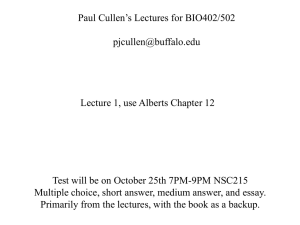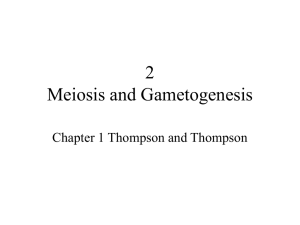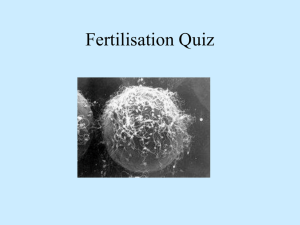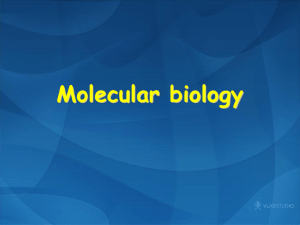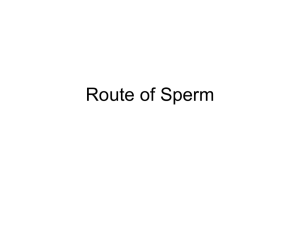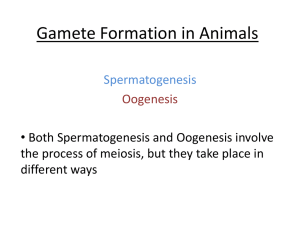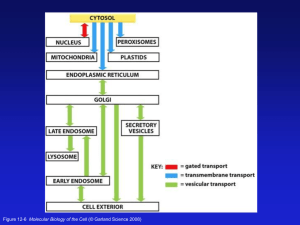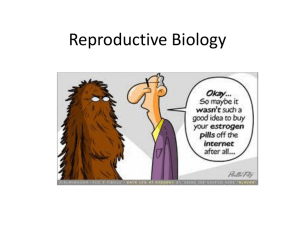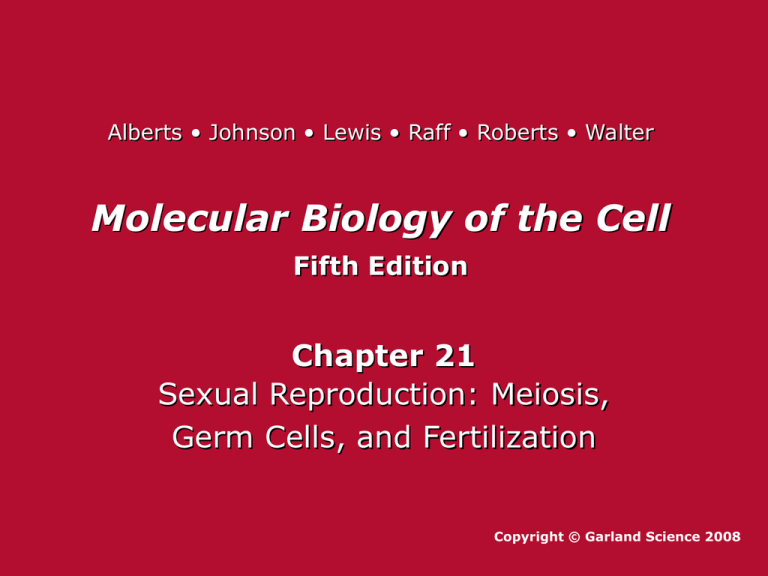
Alberts • Johnson • Lewis • Raff • Roberts • Walter
Molecular Biology of the Cell
Fifth Edition
Chapter 21
Sexual Reproduction: Meiosis,
Germ Cells, and Fertilization
Copyright © Garland Science 2008
Sex is not absolutely necessary
A hydra from which two new organisms are
budding(arrows)
Sex is not absolutely necessary.
Asexual reproduction
Sexual reproduction
Figure 21-1 Molecular Biology of the Cell (© Garland Science 2008)
Scanning electron micrograph of an egg
with many human sperm bound to its surface
유성생식은 diploid에서
Diploid: 2 sets of chromosomes
Haploid
Mitosis
Meiosis
gametes—eggs (or ova), sperm (or spermatozoa), pollen, or spores.
a fertilized egg, or zygote
Figure 21-2 Molecular Biology of the Cell (© Garland Science 2008)
Haploid and diploid cells in the life cycles
of some complex and simple eucaryotes.
The Haploid Phase in Higher Eucaryotes Is Brief
Gametes +
specified diploid precursor cells
No division
Specialized for sexual fusion
Figure 21-3 Molecular Biology of the Cell (© Garland Science 2008)
Meiosis Creates Genetic Diversity
• Autosomes and sex chromosomes
• Homologous chromosomes
• Crucial feature of meiosis
– Haploid cells are different from one another
and from the two haploid cells that formed the
organism
– Different set of autosomes
– Genetic recombination “crossing-over”
Crossing-Over Enhances Genetic Reassortment
Two major contributions to the reassortment of genetic material
that occurs in the production of gametes during meiosis.
223=8.4m
Figure 21-13 Molecular Biology of the Cell (© Garland Science 2008)
Sexual Reproduction Gives Organisms a
Competitive Advantage
A peacock displaying his elaborate tail.
Meiosis Creates Genetic Diversity
- Reshuffling of genes helps a
species to survive
The least fit male: Genetic
trashcan?
Figure 21-4 Molecular Biology of the Cell (© Garland Science 2008)
Meiosis
the Greek word for diminution or lessening
Gametes Are Produced by Two Meiotic Cell Divisions
Comparison of meiosis and mitotic cell division.
which the duplicated homologs
rather than the sister chromatids
are pulled apart and segregated
Figure 21-5 Molecular Biology of the Cell (© Garland Science 2008)
the sister chromatids are pulled apart
Duplicated Homologs (and Sex Chromosomes)
Pair During Early Prophase I
Homolog alignment and crossing-over.
엄마/아빠 염색체 조각 교환
Figure 21-6 Molecular Biology of the Cell (© Garland Science 2008)
Duplicated Homologs (and Sex Chromosomes) Pair
During Early Prophase I
Rearrangements of telomeres during prophase in developing bovine eggs.
Figure 21-7 Molecular Biology of the Cell (© Garland Science 2008)
Blue: nucleus
Red: telomeres
Sex chromosomes
• But the males have one X and one Y
chromosome.
• Although these chromosomes are not
homologous, they too must pair and
undergo crossing-over during prophase
Homolog Pairing Culminates in the Formation of a
Synaptonemal Complex
Simplified schematic drawing of a synaptonemal complex.
What pulls the axes together? One possibility is that the large protein machine, called a recombination complex,
which assembles on a double-strand break in a chromatid, binds the matching DNA sequence in the nearby
homolog and helps reel in this partner. This so-called presynaptic alignment of the homologs is followed by
synapsis, in which the axial core of a homolog becomes tightly linked to the axial core of its partner by a closely
packed array of transverse filaments to create a synaptonemal complex, which bridges the gap, now only 100 nm,
between the homologs.
Figure 21-8 Molecular Biology of the Cell (© Garland Science 2008)
Homolog Pairing Culminates in the Formation of a
Synaptonemal Complex
A bivalent with three chiasmata resulting from three crossover events
• ch 1 has undergone an
exchange with ch 3
• ch 2 has undergone
exchanges with ch 3 and
ch 4
Figure 21-10 Molecular Biology of the Cell (© Garland Science 2008)
Homolog synapsis and desynapsis
during the different stages of prophase I.
A molecular model of how transverse filaments
may be formed by a single type of protein
Comparison of chromosome behavior in meiosis I, meiosis II,
and mitosis.
When homologs fail to separate properly—a phenomenon
called nondisjunction 비분리— the result is that some of
the haploid gametes produced lack a particular chromosome,
while others have more than one copy of it. (Cells with an
abnormal number of chromosomes are said to be aneuploid
이수체, whereas those with the correct number are said to be
euploid. 정배수체)
Crossing-Over Enhances Genetic Reassortment
Crossovers between homologs in the human testis
“hot spots”
“cold spots”
Antibodies have been used to stain the synaptonemal complexes
(red), the centromeres (blue), and the sites of crossing-over (green).
Note that all of the bivalents have at least 1 crossover and none have
more than 3.
crossover interference?
Figure 21-14 Molecular Biology of the Cell (© Garland Science 2008)
Meiosis Is Regulated Differently
in Male and Female Mammals
Comparison of times required for each of the stages of meiosis
Meiosis in a human male lasts
for 24 days, compared with 12
days in the mouse.
In human females, it can last 40
years or more, because meiosis I
arrests after diplotene.
Figure 21-15 Molecular Biology of the Cell (© Garland Science 2008)
Female and male meiosis
•
In mammalian females, egg precursor cells (oocytes) begin meiosis in the fetal
ovary but arrest after diplotene, after the synaptonemal complex has
disassembled in meiosis I.
•
They complete meiosis I only after the female has become sexually mature and
the oocyte is released from the ovary during ovulation;
•
Moreover, the released oocyte completes meiosis II only if it is fertilized.
•
In humans, some oocytes remain arrested in meiosis I for 40 years or more,
which is presumably at least part of the reason why nondisjunction increases
dramatically in older women (20% of egg vs 3-4% of sperm).
Egg vs sperms
Cell cycle check point mechanism
More division mutation rate up
PRIMORDIAL GERM CELLS AND SEX
DETERMINATION IN MAMMALS
• In all vertebrate embryos, certain cells are
singled out early in development as
progenitors of the gametes.
• These diploid primordial germ cells
(PGCs) migrate to the developing gonads,
which will form the ovaries in females and
the testes in males.
Signals from Neighbors Specify PGCs in
Mammalian Embryos
Segregation of germ cell determinants in the nematode C. elegans
Vasa family: ATP-dependent RNA helicases
nuclei
Germ line precursor
P-granules:
germ cell
determinants
The P granules are composed of RNA and protein molecules and are distributed randomly
throughout the cytoplasm of the unfertilized egg (not shown). As shown in the far left-hand panels,
after fertilization, the granules accumulate at one pole of the zygote. The granules are then
segregated into one of the two daughter cells at each cell division.
Figure 21-16 Molecular Biology of the Cell (© Garland Science 2008)
PGCs Migrate into the Developing Gonads
Migration of mammalian PGCs
In human, totipotent fertilized egg cells get signal from
neibhoring cells (Bone morphogenic 4, BMP4) fate of PGC
they proliferate and migrate to their final destination in the
developing gonads
Movement: Chemokines-Protein coupled receptors PCR
Figure 21-17 Molecular Biology of the Cell (© Garland Science 2008)
The Sry Gene Directs the Developing Mammalian Gonad to
Become a Testis
Sry, for “sex-determining region of Y.”
Chromosomes of a normal human male
>1000 genes
Figure 21-18 Molecular Biology of the Cell (© Garland Science 2008)
about 80 genes
The Sry Gene Directs the Developing
Mammalian Gonad to Become a Testis
Influence of Sry on gonad development
Figure 21-19 Molecular Biology of the Cell (© Garland Science 2008)
Sry is expressed in a subpopulation of the somatic cells of the developing
gonad, and it causes these cells to differentiate into Sertoli cells, which are the
main type of supporting cells in the testis
• One crucial downstream gene: Sox9.
• The Sox9 gene is not on the Y chromosome, but it is expressed in males
in all vertebrates, unlike Sry,which is found only in mammals.
• If Sox9 is expressed ectopically in the developing gonads of an XX
mouse embryo, the embryo develops as a male, even if it lacks the Sry
gene, suggesting that Sry normally acts by inducing the expression of
Sox9.
Many Aspects of Sexual Reproduction Vary Greatly between
Animal Species
• In C. elegans and Drosophila, for example, sex is
determined by the ratio of X chromosomes to
autosomes, rather than by the presence or absence
of a Y chromosome, as in mammals.
• In C. elegans, sex determination depends mainly
on transcriptional and translational controls on
gene expression, whereas in Drosophila it depends
on a cascade of regulated RNA splicing events.
Summary
A small number of cells in the early mammalian embryo are signaled by their neighbors
to become germ-line cells. The resulting primordial germ cells (PGCs) proliferate
and migrate into the developing gonads. Here, the germ-line cells commit to develop
into either eggs, if the gonad is becoming an ovary, or sperm, if the gonad is becoming
a testis. A developing gonad will develop into an ovary unless its somatic cells contain
a Y chromosome, in which case it develops into a testis. The Sry gene on the mammalian
Y chromosome is crucial for testis development: it is expressed in a subpopulation
of somatic cells in the developing gonad and directs them to differentiate into Sertoli
cells, which then produce signal molecules that promote the development of male
characteristics, and suppress the development of female characteristics. Mammalian
embryos are programmed to follow a female pathway of development unless they are
diverted to follow the male pathway by Sertoli cells.
Egg
An Egg Is Highly Specialized for
Independent Development
The actual sizes of three eggs
Figure 21-20 Molecular Biology of the Cell (© Garland Science 2008)
An Egg Is Highly Specialized for
Independent Development
The relative sizes of various eggs, compared with
that of a typical somatic cell
york
Figure 21-21 Molecular Biology of the Cell (© Garland Science 2008)
An Egg Is Highly Specialized for
Independent Development
The zona pellucida
the major coat is a layer immediately
surrounding the egg plasma membrane:
species-specific barrier to sperm
Figure 21-22 Molecular Biology of the Cell (© Garland Science 2008)
Eggs Develop in Stages
The stages of oogenesis
난원세포
난모세포
Figure 21-23 Molecular Biology of the Cell (© Garland Science 2008)
Oocytes Use Special Mechanisms to Grow to
Their Large Size
Nurse cells and follicle cells associated with a Drosophila oocyte
The nurse cells and the oocyte
arise from a common oogonium, which
gives rise to one oocyte and 15 nurse
cells (only 7 of which are seen in this
plane of section). These cells remain
joined by cytoplasmic bridges, which
result from incomplete cell division.
Eventually, the nurse cells dump their
cytoplasmic contents into the developing
oocyte and then kill themselves.
Figure 21-24 Molecular Biology of the Cell (© Garland Science 2008)
gap junction
Most Human Oocytes Die Without Maturing
The stages in human oocyte development
Follicle stimulating hormone (FSH)
luteinizing hormone (LH) triggers ovulation
Figure 21-26 Molecular Biology of the Cell (© Garland Science 2008)
Summary
Oocytes develop in stages from primordial germ cells (PGCs) that migrate into the
developing gonad, where they become oogonia. After a period of mitotic proliferation,
the oogonia begin meiosis I and are now called primary oocytes. Primary
oocytes remain arrested after diplotene of prophase I for days to years, depending on
the species. During this arrest period, they grow, synthesize a coat, and accumulate
ribosomes, mRNAs, and proteins, often enlisting the help of other cells, including
surrounding follicle cells. Bidirectional signaling between oocytes and their follicle
cells is required for normal oocyte growth and development. In the process of
hormonally induced oocyte maturation, primary oocytes complete meiosis I to form a
small polar body and a large secondary oocyte, which proceeds to metaphase of
meiosis II. In most vertebrates, the secondary oocyte arrests at metaphase II until
stimulated by fertilization to complete meiosis and begin embryonic development.
Sperm Are Highly Adapted for Delivering
Their DNA to an Egg
A human sperm.
가수분해 효소
protamines, as well as
with sperm-specific
histones
Figure 21-27 Molecular Biology of the Cell (© Garland Science 2008)
Sperm Are Highly Adapted for Delivering
Their DNA to an Egg
Drawing of the midpiece of a mammalian sperm
as seen in cross section in an electron microscope
Figure 21-28 Molecular Biology of the Cell (© Garland Science 2008)
Sperm Are Produced Continuously
in the Mammalian Testis
Highly simplified drawings of a cross section
of a seminiferous tubule in a mammalian testis.
정원세포
Figure 21-29 Molecular Biology of the Cell (© Garland Science 2008)
Sperm Are Produced Continuously in the Mammalian Testis
The stages of spermatogenesis
Figure 21-30 Molecular Biology of the Cell (© Garland Science 2008)
Sperm Develop as a Syncytium
Cytoplasmic bridges in developing sperm cells and their precursors
Figure 21-31 Molecular Biology of the Cell (© Garland Science 2008)
Summary
A sperm is usually a small, compact cell, highly specialized for the task of fertilizing an
egg. Whereas in women a large pool of oocytes is produced before birth, in men
spermatogonia only begin to enter meiosis to produce spermatocytes (and sperm) after
sexual maturation, and they continue to do so from then on. Each diploid primary
spermatocyte gives rise to four mature haploid sperm. The process of sperm
differentiation occurs after meiosis is complete, requiring five weeks in humans.
Because the maturing spermatogonia and spermatocytes fail to complete cytokinesis,
however, the progeny of a single maturing spermatogonium develop as a large
syncytium. Thus, the products encoded by both parental chromosomes direct sperm
differentiation, even though each sperm nucleus is haploid.
Capacitated Sperm Bind to the Zona Pellucida and
Undergo an Acrosome Reaction
Scanning electron micrograph of a human sperm contacting a hamster egg
Figure 21-32 Molecular Biology of the Cell (© Garland Science 2008)
Capacitated Sperm Bind to the Zona Pellucida and
Undergo an Acrosome Reaction
The acrosome reaction that occurs when a mammalian sperm fertilizes an egg
Figure 21–33 The acrosome reaction
that occurs when a mammalian sperm
fertilizes an egg. In mice, the zona
pellucida is about 6 mm thick, and sperm
tunnel through it at a rate of about
1 mm/min.
Figure 21-33 Molecular Biology of the Cell (© Garland Science 2008)
The Cortical Reaction Helps Ensure
That Only One Sperm Fertilizes the Egg
How the cortical reaction in a mouse egg is thought to prevent
additional sperm from entering the egg
Figure 21–34
<TGAC> The released contents of the
cortical granules inactivate ZP3 so it can
no longer bind to the sperm plasma
membrane. They also partly cleave ZP2,
hardening the zona pellucida so that
sperm cannot penetrate it. Together,
these changes provide a block to
polyspermy.
M21.4
Figure 21-34 Molecular Biology of the Cell (© Garland Science 2008)
The Sperm Provides Centrioles as Well as Its
Genome to the Zygote
The coming together of the sperm and egg pronuclei
after mammalian fertilization
Figure 21-35 Molecular Biology of the Cell (© Garland Science 2008)
The Sperm Provides Centrioles as Well as Its
Genome to the Zygote
Immunofluorescence micrographs of human sperm and egg
pronuclei coming together after in vitro fertilization
Figure 21-36 Molecular Biology of the Cell (© Garland Science 2008)
IVF and ICSI Have Revolutionized the Treatment
of Human Infertility
Intracytoplasmic sperm injection (ICSI).
Figure 21-37 Molecular Biology of the Cell (© Garland Science 2008)
IVF and ICSI Have Revolutionized the Treatment
of Human Infertility
The difference between reproductive cloning and the preparation of
“personalized” embryonic stem cells
Figure 21-38 Molecular Biology of the Cell (© Garland Science 2008)
Summary
Mammalian fertilization normally begins when a sperm, which has undergone
capacitation in the female genital tract, binds to the zona pellucida surrounding an
egg in the oviduct. This induces the sperm to undergo an acrosome reaction, releasing
the contents of the acrosomal vesicle, which are thought to help the sperm to digest its
way through the zona. The acrosome reaction is also required for the sperm to bind to
and fuse with the egg plasma membrane. The fusion of the sperm with the egg induces
a Ca2+ wave and oscillations in the egg cytosol, which activate the egg. The activation
includes the egg cortical reaction, in which cortical granules release their contents,
which alter the zona pellucida so that other sperm cannot bind to or penetrate it. The
Ca2+ signal also triggers the development of the zygote, which begins after the two
haploid
pronuclei have come together and their chromosomes have aligned on a single
mitotic spindle, which mediates the first mitotic division of the zygote. Many previously
infertile couples can now reproduce thanks to IVF and ICSI.

